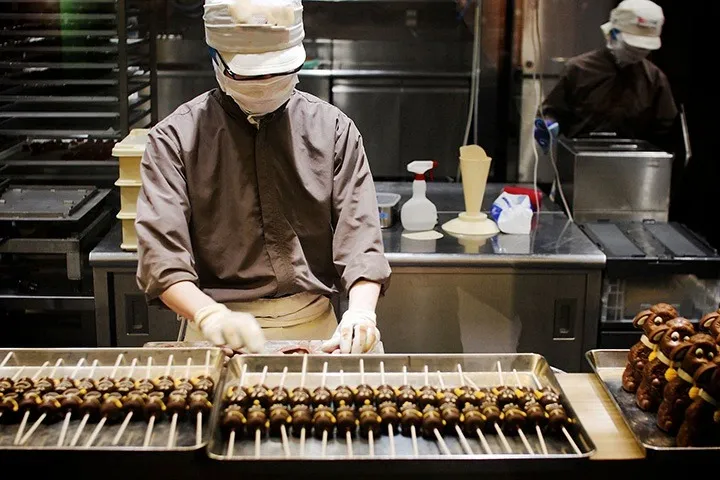The Cost of Scaling Up Production - What is Total Cost of Ownership?

One of the oft-overlooked aspects of scaling up is taking a look at Total Cost of Ownership. A TCO calculation should not just look at CapEx – Capital Expenditure, or the cost of the machines – but also factor in loss factors, labor, rent, cost of energy, and financing and depreciation, among other aspects of the processes.
I took a run at creating a naive modeling tool (it focuses on CapEx but I spent a lot of time noodling with labor and rent) and I only focused on the machines required to refine and conche chocolate as I have created other models for other parts of the process that I use in my consulting practice.
Small tabletop grinders are cheap to acquire. However, as you scale up they become relatively more (and at a point MUCH more) expensive when it comes to labor, rent, and other costs when compared with much more expensive machines.
A 2kg working bowl grinder running at full capacity (one batch/day, 6 days week – as I said, the model is naive) can produce 480kg of chocolate per year for about $300 CapEx. To get to the same capacity as a single 40L Universal (4.8 MT/yr at 3, 40kg batches/week) the CapEx is $6000; 10, 2kg grinders running full tilt can produce about the same amount of chocolate for about half the CapEx.
However, taking a look just at CapEx ignores the fact that 10, 2k grinders are going to take up a lot more space than a single 40L universal; rent should be a factor in TCO buying decisions. Also, the labor, energy, and other costs are going to be a lot higher for 10 machines than they are going to be for one machine.
2-5kg tabletop grinders are a low barrier to entry option for makers with up to ~1-2MT production/year, though the obvious tradeoff is CapEx for labor. (You are paying yourself, right? If you are not paying yourself, you still need to account for the cost of labor.)
Above 1-2MT and you need to consider larger grinders, up to and including ones with batch capacities of ~35kg.
Once you start thinking about going beyond 3-5MT of finished chocolate/year – based on my model – it’s time to start thinking about using much larger and different machines (e.g., ball mills and dedicated conches) for one simple reason: the amount and cost of labor, plus rent on the space required to house a lot of machines and all of the associated processes, makes it really, really hard to create a sustainable business.
One bit of anecdotal evidence in support of this a chocolate maker who moved from three 35kg melangeurs into a 250kg universal. Their production capacity tripled at the same time their energy bill was cut in half. The 250kg universal cost less than 2x the cost of the three melangeurs. Objectively, the quality of the chocolate improved as well with the move from the melangeurs to the universal, and a lot less hands-on time is required to produce each batch.
PLEASE do not edit the Google Doc worksheet in place. Download a copy to play. If you discover errors or make changes, please DM or email me and I will review and incorporate them into the worksheet.
Listing photo by Miki Yoshihito under CC BY 2.0. Image has been cropped and logos removed to de-identify the company.
If you have the time and skills, you could save a ton by developing the intermediate scale equipment yourself. Good designs and open source software, plus digital equipment off Amazon and the likes, are useful in designing and building a roaster. You will need to be able to source out the manufacturing of large components (mild steel roasting drums, stainless insulated shell). Same goes for converting a standard melanger to a stirred ball mill. I've found by using a charge of ceramic balls, and changing the stirrer, my melanger now give me double the output in half the time. Tempering machine was a piece of cake, once you understand the physics and chemistry. Admittedly, I'm halfway around the globe from you in Northern America, which does force me to get inventive. We're working with a group of farmers, and looks like we're going to be able to set up certified facilities, in two 20 foot containers, including all equipment, for under $50,000 – production at 5 tons per month.
Great forum, and great info from Clay, Brad, Sebastian and the leaders (which I'm still trying to figure out who's genuine, and who are punting their business).
There is an intermediary step that a growing business can take, which increases throughput at a minimal cost. That step is to purchase a mid sized (500kg) universal and use it to make your own liquor. You can then pour your rough liquor, sugar, and other ingredients into your smaller machines (cocoa towns, 40l refiners, or whatever) and simply perform your finishing refining in the smaller machines. Sugar fractures much easier than cocoa nibs, and you will find that a refine time of 48-72 hours in the smaller machines will now be reduced to 12-24 hours for the same quality chocolate. In essence you are tasking the large machine to do all of the heavy lifting that the small machines previously took a long time to do, and for a relatively low entry price you are essentially doubling or even tripling your production simply by adding one piece of equipment. I have a 1000kg Universal in my factory that I use this exact way, and we end up with decadent, smooth chocolate in our 40 litre machines in as little as 12 hours. By the way, I (or Clay) can sell the 500kg refiners at fabulous prices.